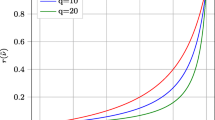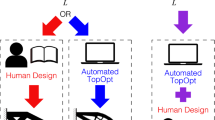Abstract
Meshes are commonly generated as a successor to geometric models in computational design and analysis. Computational analyses are performed in industry and academia for use in research, development, and manufacturing. The accuracy of these analyses depends on the fidelity of the geometric models and meshes. Element quality also plays an important role. Whereas most mesh generation strategies focus on element quality, this should be secondary to accurate representation of the real-world object. In McLaurin and Shontz (Automated edge grid generation based on arc-length optimization. In: Proceedings of the 22nd International Meshing Roundtable, pp. 385–403, Springer, Berlin, 2014), we recently proposed an automated method for generation of optimal edge grids via minimization of the arc-length deficit via a local optimization technique. In this paper, we explore the use of several different global optimization and adaptivity strategies for generation of optimal edge grids. Our results demonstrate the robustness and accuracy of our global optimization and adaptivity method for edge grid generation. We also discuss potential extensions of our method which incorporate a computational budget, achieve greater efficiency through development of a hybrid method based on local and global optimization and adaptivity, and incorporate symmetries.
Access this chapter
Tax calculation will be finalised at checkout
Purchases are for personal use only
Similar content being viewed by others
References
Hickey, A., **ao, S.: Finite element modeling and simulation of car crash. Int. J. Mod. Stud. Mech. Eng. 3, 1–5 (2017)
Villemin, R., Herv, C., Konishi, S., Tejima, T., Villemin, R., Yu, D.: Art and technology at Pixar, from toy story to today. In: SA ’15: SIGGRAPH Asia 2015 Courses, pp. 1–89 (2015)
Aycock, K., Campbell, R., Manning, K., Sastry, S., Shontz, S., Lynch, F., Craven, B.: A computational model for predicting inferior vena cava filter performance on a patient-specific basis. J. Biomech. Eng. 136, 081003 (2014)
Bischoff, S., Kobbelt, L.: Structure preserving CAD model repair. Comput. Graph. Forum 24(3), 527–536 (2005)
Cheng, S., Dey, T., Shewchuk, J.: Delaunay Mesh Generation. CRC Press, New York (2012)
Marcum, D.: Advancing-front/local-reconnection (AFLR) unstructured grid generation. In: Computational Fluid Dynamics Review, p. 140. World Scienific, Singapore (1998)
CUBIT: Geometry and Mesh Generation Toolkit. http://cubit.sandia.gov
Löhner, R., Parikh, P.: Generation of three-dimensional unstructured grids by the advancing-front method. Int. J. Numer. Meth. Fl. 8(10), 1135–1149 (1988)
Shewchuk, J.: Tetrahedral mesh generation by Delaunay refinement. In: Proceedings of the 14th Annual Symposium on Computational Geometry, pp. 86–95 (1998)
Shewchuk, J.: Delaunay refinement algorithms for triangular mesh generation. Comput. Geom. Theory Appl. 22, 21–74 (2002)
Freitag, L., Knupp, P.: Tetrahedral mesh improvement via optimization of the element condition number. Int. J. Numer. Meth. Eng. 53, 1377–1391 (2001)
Munson, T.: Mesh shape-quality optimization using the inverse mean-ratio metric. Math. Program. 110, 561–690 (2007)
Kim, J., Panitanarak, T., Shontz, S.: A multiobjective mesh optimization framework for mesh quality improvement and mesh untangling. Int. J. Numer. Meth. Eng. 94, 20–42 (2013)
Sastry, S., Shontz, S., Vavasis, S.: A log-barrier method for mesh quality improvement and untangling. Eng. Comput. 30, 315–329 (2014)
Laug, P., Borouchaki, H.: Curve linearization and discretization for meshing composite surfaces. Commun. Numer. Meth. Eng. 20, 869–876 (2004)
Macklin, P., Lowengrub, J.: An improved geometry-aware curvature discretization for level set method: Applications to tumor growth. J. Comput. Phys. 215, 392–401 (2006)
Hofer, M., Pottmann, H.: Energy-minimizing splines in manifold. In: ACM Transactions on Graphics (TOG)—Proceedings of the ACM SIGGRAPH 2004, vol. 23, pp. 284–293 (2004)
El-Zehiry, N., Grady, L.: Fast global optimization of curvature. In: Computer Vision and Pattern Recognition (Princeton, NJ), pp. 3257–3264. IEEE, New York (2010)
Ebeida, M., Davis, R., Freund, R.: A new fast hybrid adaptive grid generation technique for arbitrary dimensional domains. Int. J. Numer. Meth. Eng. 84, 305–329 (2010)
Horng, J., Li, J.: An automatic and efficient dynamic programming algorithm for polygonal approximation of digital curves. Pattern Recogn. Lett 23, 171–182 (2002)
Quadros, W., Owen, S., Brewer, M., Shimada, K.: Finite element mesh sizing for surfaces using skeleton. In: Proceedings of the 13th International Meshing Roundtable (2004)
Cabello, J.: Towards quality surface meshing. In: Proceedings of the 12th International Meshing Roundtable (2003)
Cunha, A., Canann, S., Saigal, S.: Automatic boundary sizing for 2D and 3D meshes. In: Proceedings of the 6th International Meshing Roundtable (1997)
Cuilliere, J.: A direct method for the automatic discretization of 3D parametric curves. Comput.-Aided Des. 29, 639–647 (1997)
McLaurin, D., Shontz, S., Automated edge grid generation based on arc-length optimization. In: Proceedings of the 22nd International Meshing Roundtable, pp. 385–403. Springer, Berlin (2014)
McLaurin, D.: Automated, curvature based edge-grid generation. In: Proceedings of AlaSim 2012 (Huntsville, AL), Alabama Modeling and Simulation Council (2012)
Sarfraz, M.: Interactive Curve Modeling: With Applications to Computer Graphics, Vision, and Image Processing. Springer, Berlin (2008)
Hughes, T., Cottrell, J., Bazilevs, Y.: Isogeometric analysis: CAD, finite elements, NURBS, exact geometry, and mesh refinement. Comput. Methods Appl. Mech. Eng. 194, 4135–4195 (2005)
Bazilevs, Y., Calo, V., Cottrell, J., Evans, J., Hughes, T., Lipton, S., Scott, M., Sederberg, T.: Isogeometric analysis using T-splines. Comput. Methods Appl. Mech. Eng. 199, 229–263 (2010)
Nemhauser, G., Savelsbergh, M., Sigismondi, G.: MINTO, a Mixed INTeger Optimizer. Oper. Res. Letters 15, 47–58 (1994)
MOSEKhomepage. www.mosek.com/index.php
Ralphs, T., Güzelsoy, M.: The Symphony callable library for mixed integer programming. In: The Next Wave in Computing, Optimization, and Decision Technologies, Operations Research/Computer Science Interfaces Series, vol. 29, pp. 61–76 (2005)
Hooke, R., Jeeves, T.: “Direct search” solution of numerical and statistical problems. J. ACM 8, 212–229 (1961)
Audet, C., Dennis, J.: Analysis of generalized pattern searches. SIAM J. Optim. 13, 889–903 (2003)
Acknowledgements
The work of the first author was funded in part by NSF CAREER Award ACI-1500487 (formerly ACI-1330056 and OCI-1054459) and NSF grants OAC-1808553 and CCF-1717894. The authors would like to thank the anonymous referee for his/her careful reading of the paper and for his/her helpful suggestions which strengthened it.
Author information
Authors and Affiliations
Corresponding author
Editor information
Editors and Affiliations
Rights and permissions
Copyright information
© 2022 The Author(s), under exclusive license to Springer Nature Switzerland AG
About this chapter
Cite this chapter
Shontz, S.M., McLaurin, D. (2022). A Global Optimization and Adaptivity-Based Algorithm for Automated Edge Grid Generation. In: Sevilla, R., Perotto, S., Morgan, K. (eds) Mesh Generation and Adaptation. SEMA SIMAI Springer Series, vol 30. Springer, Cham. https://doi.org/10.1007/978-3-030-92540-6_14
Download citation
DOI: https://doi.org/10.1007/978-3-030-92540-6_14
Published:
Publisher Name: Springer, Cham
Print ISBN: 978-3-030-92539-0
Online ISBN: 978-3-030-92540-6
eBook Packages: Mathematics and StatisticsMathematics and Statistics (R0)




